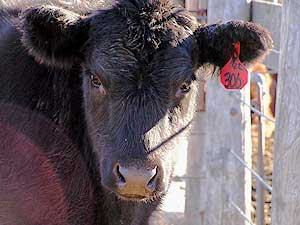|
Photos
More from MPR
Resources
|
July 14, 2005
A herd of 900 cattle in northern Minnesota will be destroyed to prevent the spread of bovine tuberculosis. Agriculture officials are confident the outbreak was caught in time to keep it from spreading. Some say this outbreak shows why the nation needs to speed implementation of a national livestock tracking system.
Collegeville, Minn. — The case of bovine tuberculosis was found in a beef cow from Roseau County in northern Minnesota. A USDA inspector detected tuberculosis after the cow was slaughtered in Green Bay, Wisconsin. Minnesota officials quarantined the herd, then tested 21 cows. Nearly all came back positive.
To prevent the disease from spreading, the USDA will pay the rancher market value for the cattle, and have them destroyed. The last time bovine TB showed up in Minnesota was 34 years ago, in 1971.
Veterinarian Bill Hartmann with the Minnesota Board of Animal Health has begun to investigate the outbreak from a number of angles.
"We'll trace out the herds where he sold animals so that we can see if it spread beyond his herd. And then the other focus will be to trace back where he purchased animals to see if we can determine a source for the infection," Hartmann said.
Consumers shouldn't worry about bovine TB, according to Hartmann. It's a respiratory disease caused by bacteria. The bacteria can't find it's way into meat, but it can be transmitted to humans through a cow's milk, if the milk isn't pasteurized. Cases of cattle to human transmission of TB haven't been a problem for more than 100 years.
The main concern for Minnesota cattle producers would be the loss of the state's TB-free label. That could happen if officials find the disease is widespread across the state.
Minnesota's Commissioner of Agriculture Gene Hugoson says that's not likely to happen, but it's a concern.
"Because if Minnesota were to lose its TB-free status, then that would mean each animal that left the state would have to be tested before it could be shipped," Hugoson said.
That wouldn't shut down cattle production in Minnesota, but Hugoson said it would add an extra production cost for ranchers.
After years of fearing outbreaks of mad cow disease or hoof and mouth disease, bovine tuberculosis is something more for ranchers to worry about.
Denny Blowers has 200 head of cattle on a ranch near Motley in central Minnesota. Even if Blowers' cattle aren't sick, he can't be sure they won't catch a disease from someone else's animals. He's now worried about using a pasture across the road from another small herd.
"There's 30 head across the fence. Who knows where they came from. I'm sure they're multiple owners, and you don't know what they've been in contact with," Blowers said.
Some agriculture officials say this a prime example of why the country needs a way to track livestock. The USDA is currently developing a system called the National Animal Identification System, but it's in the early stages.
When in place, it will track livestock anywhere in the country using a radio transmitter attached to the animal.
Dave Wicklund with the Minnesota Board of Animal Heath is in charge of implementing NAIS in Minnesota. Wicklund says the TB outbreak will take weeks, if not months, to investigate. He says the same investigation would take much less time with the NAIS.
"This investigation will spread out throughout the state to other herds, and it's going to require a lot of time and backtracking. In the future, when a system like the NAIS program is up and running, we could do that in a matter of minutes," Wicklund said.
Wicklund says the USDA's livestock tracking system will be a mandatory program for livestock producers across the country. The USDA wants the system to be up and running by 2009.




